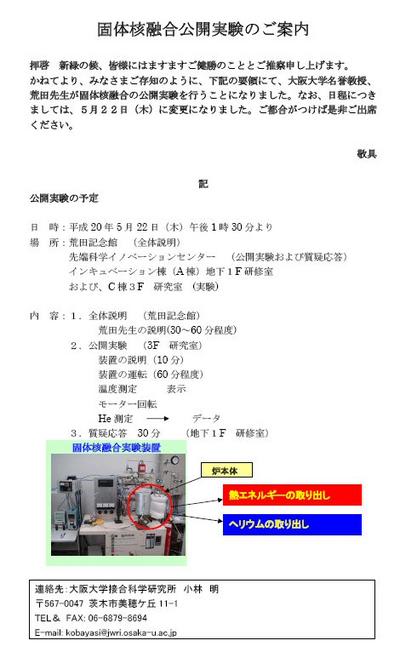クルマやバイクが電動になっても、その電気エネルギーをどうやって確保するのが問題です。
世界的には原発が再び増設される動きもあったりしますが、アメリカや中国はまだ石炭の火力発電が主力だそうです。
大阪大学の荒田名誉教授は、昨年の5月22日に常温核融合の公開実験を成功させたにもかかわらず、中々認められませんでした。
研究を続けるには資金が必要ですが、ネットジャーナリストのRichard Koshimizu氏が率先して個人寄付を集め現在のところ継続しているようです。(参照ttp://richardkoshimizu.at.webry.info/)
日本では認められませんでしたが、とうとうアメリカの学会に認められてようです。(以下引用の引用ですが、参照ttp://green.ap.teacup.com/shinjidai/1137.html)
ワタシはこうした新エネルギーが実用化されてエネルギーのシェアがうまく機能できれば、原油の価格は安定したり、地球温暖化炭酸ガス犯人説により目の敵にされている内燃機関の寿命も逆に先に延びるのではないかと期待してしまいます。
A March 23 press release by the American Chemical Society, a flagship peer review organization of mainstream science, states:
米国化学学会、すなわち米国化学会の指導的審査機関は3月23日は以下の発表を行った
Researchers are reporting compelling説得力{せっとくりょく}のある new scientific evidence for the existence of low-energy nuclear reactions (LENR), the process once called "cold fusion" that may promise望みがある a new source of energy.
研究者たちは低エネルギー核反応の実在に関する説得力のある新証拠を発表した。LENRは以前常温核融合と呼ばれており、新エネルギー源として可能性がある。
One group of scientists, for instance, describes what it terms the first clear visual evidence that LENR devices can produce neutrons, subatomic particles that scientists view as tell-tale signs that nuclear reactions are occurring.
たとえばひとつの科学者グループはLENR装置がはっきりと目に見える形で、中性子を作りうることを示した。中性子の発生は科学者が核反応が起こっているとみなすサインである。
Low-energy nuclear reactions could potentially provide 21st Century society a limitless and environmentally-clean energy source for generating electricity, researchers say. The report, which injects new life into this controversial field, will be presented here today at the American Chemical Society's 237th National Meeting. It is among 30 papers on the topic that will be presented during a four-day symposium, "New Energy Technology," March 22-25, in conjunction with the 20th anniversary of the first description of cold fusion.
"Our finding is very significant," says study co-author and analytical chemist Pamela Mosier-Boss, Ph.D., of the U.S. Navy's Space and Naval Warfare Systems Center (SPAWAR) in San Diego, Calif. "To our knowledge, this is the first scientific report of the production of highly energetic neutrons from an LENR device."
The first report on "cold fusion," presented in 1989 by Martin Fleishmann and Stanley Pons, was a global scientific sensation. Fusion is the energy source of the sun and the stars. Scientists had been striving for years to tap that power on Earth to produce electricity from an abundant fuel called deuterium that can be extracted from seawater. Everyone thought that it would require a sophisticated new genre of nuclear reactors able to withstand temperatures of tens of millions of degrees Fahrenheit.
Pons and Fleishmann, however, claimed achieving nuclear fusion at comparatively "cold" room temperatures ― in a simple tabletop laboratory device termed an electrolytic cell.
But other scientists could not reproduce their results, and the whole field of research declined. A stalwart cadre of scientists persisted, however, seeking solid evidence that nuclear reactions can occur at low temperatures. One of their problems involved extreme difficulty in using conventional electronic instruments to detect the small number of neutrons produced in the process, researchers say.
In the new study, Mosier-Boss and colleagues inserted an electrode composed of nickel or gold wire into a solution of palladium chloride mixed with deuterium or "heavy water" in a process called co-deposition. A single atom of deuterium contains one neutron and one proton in its nucleus.
Researchers passed electric current through the solution, causing a reaction within seconds. The scientists then used a special plastic, CR-39, to capture and track any high-energy particles that may have been emitted during reactions, including any neutrons emitted during the fusion of deuterium atoms.
At the end of the experiment, they examined the plastic with a microscope and discovered patterns of "triple tracks," tiny-clusters of three adjacent pits that appear to split apart from a single point. The researchers say that the track marks were made by subatomic particles released when neutrons smashed into the plastic. Importantly, Mosier-Boss and colleagues believe that the neutrons originated in nuclear reactions, perhaps from the combining or fusing deuterium nuclei.
"People have always asked 'Where's the neutrons?'" Mosier-Boss says. "If you have fusion going on, then you have to have neutrons. We now have evidence that there are neutrons present in these LENR reactions."
They cited other evidence for nuclear reactions including X-rays, tritium (another form of hydrogen), and excess heat. Meanwhile, Mosier-Boss and colleagues are continuing to explore the phenomenon to get a better understanding of exactly how LENR works, which is key to being able to control it for practical purposes.
Mosier-Boss points out that the field currently gets very little funding and, despite its promise, researchers can't predict when, or if, LENR may emerge from the lab with practical applications. The U.S. Department of the Navy and JWK International Corporation in Annandale, Va., funded the study.
Other highlights in the symposium include:
Overview, update on LENR by editor of New Energy Times ? Steve Krivit, editor of New Energy Times and author of "The Rebirth of Cold Fusion," will present an overview of the field of low energy nuclear reactions, formerly known as "cold fusion." A leading authority on the topic, Krivit will discuss the strengths, weaknesses, and implications of this controversial subject, including its brief history. (ENVR 002, Sunday, March 22, 8:55 a.m. Hilton, Alpine Ballroom West, during the symposium, "New Energy Technology)
Excess heat, gamma radiation production from an unconventional LENR device ―Tadahiko Mizuno, Ph.D., of Hokkaido University in Japan, has reported the production of excess heat generation and gamma ray emissions from an unconventional LENR device that uses phenanthrene, a type of hydrocarbon, as a reactant. He is the author of the book "Nuclear Transmutation: The Reality of Cold Fusion." (ENVR 049, Monday, March 23, 3:35 p.m., Hilton, Alpine Ballroom West, during the symposium, "New Energy Technology.")
New evidence supporting production and control of low energy nuclear reactions ― Antonella De Ninno, Ph.D., a scientist with New Technologies Energy and Environment in Italy, will describe evidence supporting the existence of low energy nuclear reactions. She conducted lab experiments demonstrating the simultaneous production of both excess heat and helium gas, tell-tale evidence supporting the nuclear nature of LENR. She also shows that scientists can control the phenomenon. (ENVR 064, Tuesday, March 24, 10:10 a.m., Hilton, Alpine Ballroom West, during the symposium, "New Energy Technology)
About ACS
The American Chemical Society is a nonprofit organization chartered by the U.S. Congress. With more than 154,000 members, ACS is the world's largest scientific society and a global leader in providing access to chemistry-related research through its multiple databases, peer-reviewed journals and scientific conferences. Its main offices are in Washington, D.C., and Columbus, Ohio










